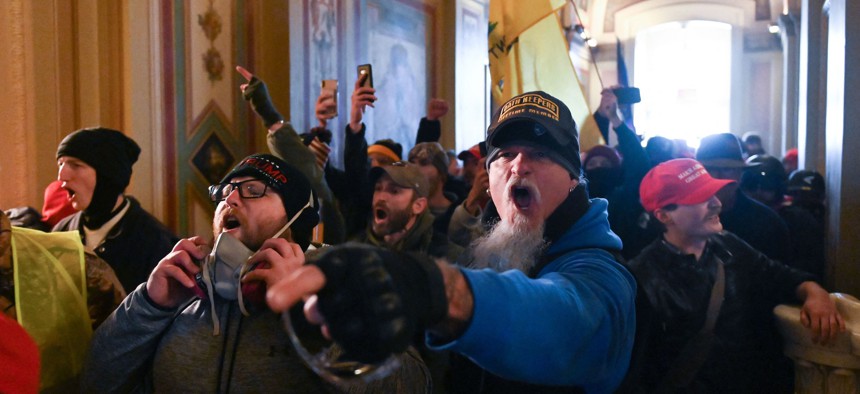
Supporters of US President Donald Trump protest inside the US Capitol on January 6, 2021, in Washington, DC. AFP via Getty Images / ROBERTO SCHMIDT
One Year After Jan. 6 Attack, Push For Quick Reaction Force Is Dead On Capitol Hill
Experts also warn changes at DOD won’t speed up how quickly Guardsmen could respond to future incidents.
After the Jan. 6 insurrection at the Capitol that left members hiding in offices or crouching under desks on the House floor, lawmakers clamored for a military quick reaction force that could protect against more violence.
One year after the attack, the idea of a military unit to respond quickly has fizzled on Capitol Hill.
Last March, the Capitol Security Review Task Force recommended that Congress establish a quick reaction force within the D.C. National Guard to respond to crises at the Capitol. That followed the Jan. 6 attack, in which a mob of right-wing extremists overpowered police, entered the building, destroyed property, and threatened lawmakers. It took three hours for National Guardsmen to arrive on the scene, and they remained at the Capitol until May.
The report recommended that the quick reaction force consist of law enforcement personnel, rotations of military police from National Guard units across the country, or a permanent military police battalion within the D.C. National Guard.
In May, the House passed a $1.9 billion supplemental funding bill that included $200 million to establish a military quick reaction force. But that language was not in the version the president signed in July.
Rep. Rosa DeLauro, D-Conn., who chairs the House Appropriations Committee, said she “strongly supported” the plan to create a quick reaction force.
“Unfortunately, opposition in the Senate led this proposal to be dropped from the final version of the Emergency Security Supplemental to Respond to January 6th,” she said in a statement.
Arnold Punaro, a retired Marine Corps officer who criticized proposals for a military quick reaction force, said he believes the idea came from people who did not understand the role of the National Guard and Reserves, or the different roles law enforcement and the military should play. But he said support waned once lawmakers understood.
“It’s totally dead,” said Punaro, who is chief executive officer of The Punaro Group consulting firm. “I didn’t see any support once people aired out all the problems with such an approach.”
Republican national security leaders on Capitol Hill and Pentagon officials were always against the plan, in part because members of the National Guard and Reserves work civilian jobs so can’t always be ready to quickly respond to a threat. In May, Sen. Jim Inhofe, R-Okla., and Rep. Mike Rogers, R-Ala., the ranking members of the Senate and House Armed Services Committees, said civilian law enforcement officials, not military troops, must be responsible for protecting the Capitol.
“We cannot and should not militarize the security of the Capitol complex,” they said in a joint statement.
Punaro agreed that law enforcement should be the first line of defense for attacks against the Capitol, but added that if the District ever does need a military quick reaction force, trained active-duty groups already exist nearby: the Old Guard at Fort Myer in Virginia and two rifle companies at Marine Barracks Washington, about a mile and a half from the Capitol.
The Pentagon did simplify the process for approving D.C. National Guard activation in case of a crisis, after the Defense Department faced criticism for its slow response to the Jan. 6 attack. Because the District is not a state and does not have a governor, approval for National Guard activities rests with the president, though that authority was delegated to the defense secretary, who further passed it down to the Army secretary.
Defense Secretary Lloyd Austin said last week that he was streamlining that process and elevating the approval so that requests to use the D.C. National Guard in emergency or law enforcement situations would go through him.
But it’s not clear that getting quicker approval would actually get troops on scene any faster.
“Just because they can get a quicker answer, it doesn’t mean they’re going to show up in five minutes or five hours,” Punaro said.
John Goheen, communications director at the National Guard Association of the United States, agreed that the shift is “not a huge change. “It may be a little faster, but the authority was delegated to the Army, now it’s not. It’s not an enormous change,” he said.
The Capitol Security Review Task Force also recommended several changes to the Capitol Police force, including boosting its intelligence capabilities, filling hundreds of vacancies, and reviving a horse-mounted police unit.
A spokesperson for the Capitol Police did not respond to a request for comment on whether the force had taken steps to address those changes.





